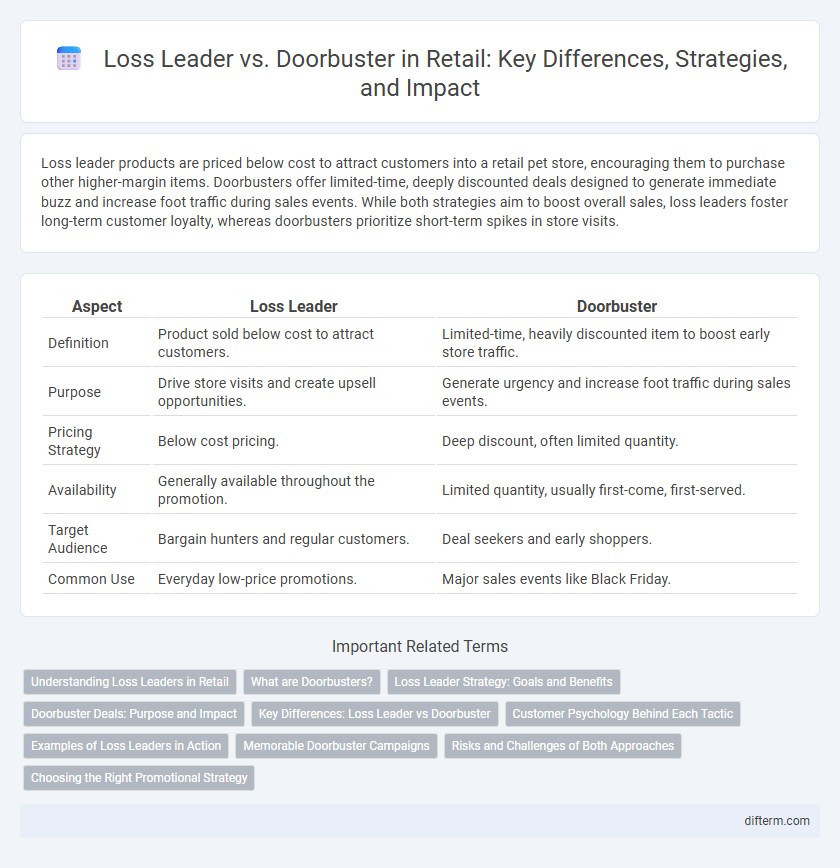Loss leader products are priced below cost to attract customers into a retail pet store, encouraging them to purchase other higher-margin items. Doorbusters offer limited-time, deeply discounted deals designed to generate immediate buzz and increase foot traffic during sales events. While both strategies aim to boost overall sales, loss leaders foster long-term customer loyalty, whereas doorbusters prioritize short-term spikes in store visits.
Table of Comparison
| Aspect | Loss Leader | Doorbuster |
|---|---|---|
| Definition | Product sold below cost to attract customers. | Limited-time, heavily discounted item to boost early store traffic. |
| Purpose | Drive store visits and create upsell opportunities. | Generate urgency and increase foot traffic during sales events. |
| Pricing Strategy | Below cost pricing. | Deep discount, often limited quantity. |
| Availability | Generally available throughout the promotion. | Limited quantity, usually first-come, first-served. |
| Target Audience | Bargain hunters and regular customers. | Deal seekers and early shoppers. |
| Common Use | Everyday low-price promotions. | Major sales events like Black Friday. |
Understanding Loss Leaders in Retail
Loss leaders in retail are strategically priced products sold below cost to attract customers and drive store traffic, increasing overall sales of higher-margin items. Unlike doorbusters, which are limited-time, highly discounted offers designed to create urgency during events, loss leaders function as a long-term tactic to build customer loyalty and promote cross-selling. Retailers use loss leaders to balance profit margins while stimulating repeat visits and expanding market share.
What are Doorbusters?
Doorbusters are highly discounted retail items promoted to attract a large number of customers during limited-time sales events, often available only at the store opening or for a short period. These offers create urgency and excitement, driving foot traffic and encouraging additional purchases of regular-priced merchandise. Doorbusters differ from loss leaders by their time-sensitive availability and emphasis on drawing immediate consumer attention rather than sustained price strategy.
Loss Leader Strategy: Goals and Benefits
Loss leader strategies aim to attract customers by offering popular products at below-cost prices, increasing store traffic and encouraging additional purchases of higher-margin items. This approach boosts customer loyalty and brand recognition by providing exceptional value that drives repeat visits. Retailers benefit from enhanced inventory turnover and improved overall profitability through strategic cross-selling opportunities.
Doorbuster Deals: Purpose and Impact
Doorbuster deals are specially priced promotions designed to attract a high volume of customers into retail stores by offering significant discounts on limited-quantity items. These deals create a sense of urgency and excitement, driving immediate foot traffic and increasing overall sales during key shopping events like Black Friday. Retailers leverage doorbuster deals to boost brand visibility and encourage additional purchases beyond the discounted items.
Key Differences: Loss Leader vs Doorbuster
Loss leaders are products sold at a price below cost to attract customers and stimulate sales of other profitable items, leveraging consumer foot traffic and cross-selling opportunities. Doorbusters are deeply discounted items available for a limited time or quantity, designed to create urgency and drive immediate store visits, often linked to special sales events. The key difference lies in their strategic intent: loss leaders prioritize long-term customer engagement and basket expansion, whereas doorbusters focus on short-term spikes in store traffic and rapid inventory turnover.
Customer Psychology Behind Each Tactic
Loss leader pricing exploits consumers' desire for bargains by offering popular products below cost to increase store traffic and encourage additional purchases, which leverages the psychological principle of perceived value and scarcity. Doorbusters capitalize on urgency and fear of missing out (FOMO), driving customers to act quickly to secure limited-quantity deals often available only during specific times, intensifying impulse buying behavior. Both tactics manipulate customer psychology to boost sales volume but differ in timing and scarcity emphasis, influencing shopping patterns and brand loyalty.
Examples of Loss Leaders in Action
Retailers use loss leaders like discounted milk or bread to drive foot traffic and encourage additional purchases, exemplified by grocery stores offering staple items below cost. Major electronics retailers often price popular gadgets as loss leaders to attract customers who then buy higher-margin accessories. Walmart's strategy of selling everyday essentials at minimal profit demonstrates loss leaders' effectiveness in boosting overall sales volume.
Memorable Doorbuster Campaigns
Memorable doorbuster campaigns in retail often leverage limited-time, deeply discounted items designed to create urgency and drive massive foot traffic, such as Walmart's Black Friday deals on electronics. Unlike loss leaders, which are strategically priced items intended to boost overall sales, doorbusters focus on creating excitement through exclusive, high-demand products available only in limited quantities. These campaigns generate significant buzz and consumer anticipation, resulting in rapid inventory turnover and increased purchases throughout the store.
Risks and Challenges of Both Approaches
Loss leader strategies risk eroding profit margins as products are sold below cost to attract customers, potentially leading to unsustainable financial losses if not balanced by high-margin sales. Doorbuster deals often create operational challenges such as inventory shortages, excessive customer congestion, and increased staff strain, which can damage brand reputation and customer satisfaction. Both approaches require precise demand forecasting and effective inventory management to mitigate risks of overstocking or stockouts and to ensure long-term profitability.
Choosing the Right Promotional Strategy
Loss leader promotions involve selling select products below cost to attract customers, boosting overall store traffic and ancillary sales. Doorbusters offer deeply discounted items in limited quantities during peak shopping times to generate urgency and excitement. Choosing the right strategy depends on inventory levels, target customer behavior, and desired impact on foot traffic versus profit margins.
Loss Leader vs Doorbuster Infographic

 difterm.com
difterm.com